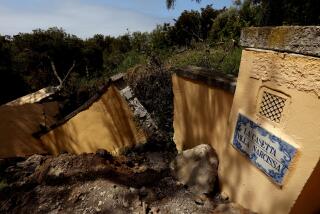In Support of Saving Canyon
Since the appearance of Kenneth Garcia’s story about Las Pulgas Canyon, (Times, June 12) we have been deluged with requests to explain further the predicament of this 26.6-acre canyon. Concern about the future of Las Pulgas Canyon appears to be part of the larger issue of the quality of life in Los Angeles. Save Las Pulgas Canyon Inc., wants to conserve the remaining open and undeveloped areas in the Pacific Palisades, Santa Monica and Malibu; we want to preserve and enhance the existing, natural fauna and flora of these areas, and we see our purpose as an educational attempt to achieve permanent solutions of benefit to the greater community. We are supported by over 3,000 people whose names appear on a petition to Councilman Marvin Braude directed against any development within Las Pulgas Canyon. Our opposition to the proposed development of Las Pulgas Canyon is based upon an historic, economic and environmental analysis, which leads us to conclude that development is as unfeasible as it is undesirable.
Since 1958, the canyon has been used intermittently as a dump for dirt collected in the owner’s excavation and engineering company. In approximately 1975, after widespread outcry against the abuse of the canyon and the noise and pollution caused by the dumping, the owner no longer used the site for his dirt. Pintoresca Drive, a street abutting an additional parcel of 11 lots on the canyon, was closed by the city following major landslides. Building never occurred, nor were there even any permits to build granted on either of these holdings because the land throughout was notoriously fragile and unstable. Four homes have fallen into the canyon and a major slide occurred at the canyon entrance on the Pacific Coast Highway. But now, a developer is in the process of purchasing the canyon.
Proposed development would include bringing in fill. If the canyon were to be filled only partially, that would involve approximately a million cubic yards of dirt. Since each double truck carries about 12 cubic yards, even a partial fill would require 83,000 truckloads of dirt. A fill of this volume would take more than a decade to complete, and it would irrevocably destroy the canyon and its irreplaceable flora and fauna. Moreover, it would be impossible to get such a volume of fill and deliver it in an orderly fashion without a disastrous impact on existing traffic. The only access for a continuous convoy of trucks carrying fill would be through the Pacific Coast Highway, which has already exceeded its capacity for present traffic.
Perhaps the most compelling argument against any development is an environmental one. Las Pulgas is the one remaining canyon which could be converted to a coastal refuge, where adults and children could come by existing public transportation to enjoy its many unique attractions. Unlike other areas in the Santa Monica mountains which are far from public transportation and difficult to find, the entrance to the canyon is across the street from the most popular of Los Angeles beaches. An open and undeveloped canyon, rich in indigenous fauna, flora, wildlife, streams, and archeological and Indian artifacts, is a heritage that we have no right to deny to this city’s urban population, many of whom have never experienced a wild area. In addition, our schools could use the canyon as a centrally located, living classroom for teaching biology, botany, geology, archeology and history.
Our city has a regrettable national reputation for squandering its natural resources. Councilman Braude, who has repeatedly demonstrated his commitment to the greater public good, has pledged his unqualified support. Through public and private efforts, this land could be acquired for public use. We believe that Las Pulgas Canyon can be saved from an imminent threat of development, and we welcome any help which you and your readers can give us.
REBA N. SOFFER
Save Las Pulgas Canyon Inc.
More to Read
Sign up for Essential California
The most important California stories and recommendations in your inbox every morning.
You may occasionally receive promotional content from the Los Angeles Times.









